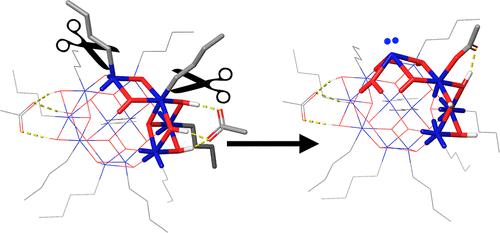当前位置:
X-MOL 学术
›
J. Phys. Chem. C
›
论文详情
Our official English website, www.x-mol.net, welcomes your
feedback! (Note: you will need to create a separate account there.)
XUV Absorption Spectroscopy and Photoconversion of a Tin-Oxo Cage Photoresist
The Journal of Physical Chemistry C ( IF 3.3 ) Pub Date : 2024-02-27 , DOI: 10.1021/acs.jpcc.3c07480
Najmeh Sadegh 1 , Quentin Evrard 1 , Peter M Kraus 1, 2 , Albert M Brouwer 1, 3
The Journal of Physical Chemistry C ( IF 3.3 ) Pub Date : 2024-02-27 , DOI: 10.1021/acs.jpcc.3c07480
Najmeh Sadegh 1 , Quentin Evrard 1 , Peter M Kraus 1, 2 , Albert M Brouwer 1, 3
Affiliation

|
Extreme ultraviolet lithography has recently been introduced in high-volume production of integrated circuits for manufacturing the smallest features in high-end computer chips. Hybrid organic/inorganic materials are considered as the next generation of photoresists for this technology, but detailed knowledge about the response of such materials to the ionizing radiation used (13.5 nm, 92 eV) is still scarce. In the present work, we use broadband high-harmonic radiation in the energy range 22–70 eV for absorption spectroscopy and photobleaching (that is, the decrease of absorbance) of thin films of an n-butyltin oxo-cage, a representative of the class of metal-based EUV photoresist. The shape of the absorption spectrum in the range 22–92 eV matches well with the spectrum predicted using tabulated atomic cross sections. The photobleaching results are consistent with loss of the butyl side groups due to the breaking of Sn–C bonds following photoionization. Bleaching is strongest in the low-energy range (<40 eV), where the absorption is largely due to the carbon atoms in the organic groups. At higher energies (42–70 eV), absorption is dominated by the tin atoms, and since these remain in the film after photoconversion, the absorption change in this region is smaller. It is estimated that after prolonged irradiation (up to ∼3 J cm–2 in the range 22–40 eV) about 70% of the hydrocarbon groups are removed from the film. The rate of bleaching is high at the beginning of exposure, but it rapidly decreases with increasing conversion. We rationalize this using density functional theory calculations: the first Sn–C bonds are efficiently cleaved (quantum yield Φ ≈ 0.9), because the highest occupied molecular orbitals (HOMOs) (from which an electron is removed after photoionization) are located on Sn–C sigma bonds. In the photoproducts, the HOMO is localized on tin atoms that have lost their hydrocarbon group (formally reduced to the Sn(II) oxidation state), and holes formed on those tin atoms lead to less efficient cleavage reactions. Our results reveal the primary reaction steps following excitation with ionizing radiation of tin-oxo cages. Our methodology represents a systematic approach of studying and quantitatively assessing the performance of new photoresists and as such enables the development of future EUV photoresists.
中文翻译:

锡氧笼光刻胶的 XUV 吸收光谱和光转换
极紫外光刻最近已被引入集成电路的大批量生产中,用于制造高端计算机芯片中最小的特征。有机/无机杂化材料被认为是该技术的下一代光刻胶,但有关此类材料对所用电离辐射(13.5 nm,92 eV)响应的详细知识仍然很少。在目前的工作中,我们使用能量范围 22-70 eV 的宽带高次谐波辐射对正丁基锡氧笼薄膜进行吸收光谱和光漂白(即吸光度降低),正丁基锡氧笼薄膜是正丁基锡氧笼薄膜的代表。类金属基 EUV 光刻胶。 22-92 eV 范围内的吸收光谱形状与使用列表原子横截面预测的光谱非常匹配。光漂白结果与光电离后 Sn-C 键断裂导致丁基侧基损失一致。漂白在低能范围内最强(<40 id=26>–2 在 22–40 eV 范围内),约 70% 的烃基从薄膜中去除。漂白率在接触开始时很高,但随着转化率的增加而迅速降低。我们使用密度泛函理论计算对此进行合理化:第一个 Sn-C 键被有效裂解(量子产率 Φ ≈ 0.9),因为最高占据分子轨道(HOMO)(光电离后从中除去电子)位于 Sn- C西格玛债券。在光产物中,HOMO 位于已失去烃基的锡原子上(形式上还原为 Sn(II) 氧化态),并且在这些锡原子上形成的空穴导致裂解反应效率较低。 我们的结果揭示了锡氧笼电离辐射激发后的主要反应步骤。我们的方法代表了一种研究和定量评估新型光刻胶性能的系统方法,因此能够开发未来的 EUV 光刻胶。
更新日期:2024-02-27
中文翻译:

锡氧笼光刻胶的 XUV 吸收光谱和光转换
极紫外光刻最近已被引入集成电路的大批量生产中,用于制造高端计算机芯片中最小的特征。有机/无机杂化材料被认为是该技术的下一代光刻胶,但有关此类材料对所用电离辐射(13.5 nm,92 eV)响应的详细知识仍然很少。在目前的工作中,我们使用能量范围 22-70 eV 的宽带高次谐波辐射对正丁基锡氧笼薄膜进行吸收光谱和光漂白(即吸光度降低),正丁基锡氧笼薄膜是正丁基锡氧笼薄膜的代表。类金属基 EUV 光刻胶。 22-92 eV 范围内的吸收光谱形状与使用列表原子横截面预测的光谱非常匹配。光漂白结果与光电离后 Sn-C 键断裂导致丁基侧基损失一致。漂白在低能范围内最强(<40 id=26>–2 在 22–40 eV 范围内),约 70% 的烃基从薄膜中去除。漂白率在接触开始时很高,但随着转化率的增加而迅速降低。我们使用密度泛函理论计算对此进行合理化:第一个 Sn-C 键被有效裂解(量子产率 Φ ≈ 0.9),因为最高占据分子轨道(HOMO)(光电离后从中除去电子)位于 Sn- C西格玛债券。在光产物中,HOMO 位于已失去烃基的锡原子上(形式上还原为 Sn(II) 氧化态),并且在这些锡原子上形成的空穴导致裂解反应效率较低。 我们的结果揭示了锡氧笼电离辐射激发后的主要反应步骤。我们的方法代表了一种研究和定量评估新型光刻胶性能的系统方法,因此能够开发未来的 EUV 光刻胶。

































 京公网安备 11010802027423号
京公网安备 11010802027423号